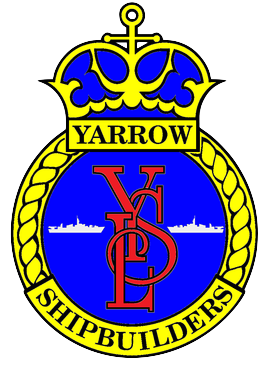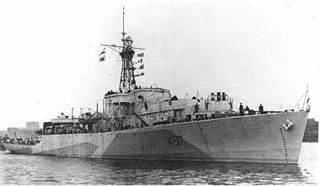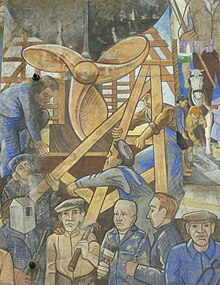
Cammell Laird is a British shipbuilding company. It was formed from the merger of Laird Brothers of Birkenhead and Johnson Cammell & Co of Sheffield at the turn of the twentieth century. The company also built railway rolling stock until 1929, when that side of the business was separated and became part of the Metropolitan-Cammell Carriage & Wagon Company.

The Flower-class corvette was a British class of 294 corvettes used during World War II by the Allied navies particularly as anti-submarine convoy escorts in the Battle of the Atlantic. Royal Navy ships of this class were named after flowers.

The Tacoma class of patrol frigates served in the United States Navy during World War II and the Korean War. Originally classified as gunboats (PG), they were reclassified as patrol frigates (PF) on 15 April 1943. The class is named for its lead ship, Tacoma, a Maritime Commission (MARCOM) S2-S2-AQ1 design, which in turn was named for the city of Tacoma, Washington. Twenty-one ships were transferred to the British Royal Navy, in which they were known as Colony-class frigates, and twenty-eight ships were transferred under Lend-Lease to the Soviet Navy, where they were designated as storozhevoi korabl, during World War II. All Tacoma-class ships in US service during World War II were manned by United States Coast Guard crews. Tacoma-class ships were transferred to the United States Coast Guard and various navies post-World War II.

Swan Hunter, formerly known as Swan Hunter & Wigham Richardson, is a shipbuilding design, engineering, and management company, based in Wallsend, Tyne and Wear, England.

The Castle-class corvette was an ocean going convoy escort developed by the United Kingdom during the Second World War. It was the follow-on to the Flower-class corvette, and designed to be built in shipyards that were producing the Flowers. The Castle-class was a general improvement over the smaller Flowers which were designed for coastal rather than open ocean use.

The River class was a class of 151 frigates launched between 1941 and 1944 for use as anti-submarine convoy escorts in the North Atlantic. The majority served with the Royal Navy and Royal Canadian Navy (RCN), with some serving in the other Allied navies: the Royal Australian Navy (RAN), the Free French Naval Forces, the Royal Netherlands Navy and, post-war, the South African Navy.

Yarrow Shipbuilders Limited (YSL), often styled as simply Yarrows, was a major shipbuilding firm based in the Scotstoun district of Glasgow on the River Clyde. It is now part of BAE Systems Surface Ships, owned by BAE Systems, which has also operated the nearby Govan shipyard since 1999.

The Algerine-class minesweeper was a large group of minesweepers built for the Royal Navy (RN) and the Royal Canadian Navy (RCN) during the Second World War. 110 ships of the class were launched between 1942 and 1944.

The Loch class was a class of anti-submarine (A/S) frigate built for the Royal Navy and her Allies during World War II. They were an innovative design based on the experience of three years of fighting in the Battle of the Atlantic and attendant technological advances. Some shipyards had trouble building these larger ships, which led to widespread use of the Castle-class corvette, introduced around the same time.

Ailsa Shipbuilding Company was a Scottish shipbuilding company based in Troon and Ayr, Ayrshire.

Scotts Shipbuilding and Engineering Company Limited, often referred to simply as Scotts, was a Scottish shipbuilding company based in Greenock on the River Clyde. In its time in Greenock, Scotts built over 1,250 ships.
R. & W. Hawthorn, Leslie and Company, Limited, usually referred to as Hawthorn Leslie, was a shipbuilder and locomotive manufacturer. The company was founded on Tyneside in 1886 and ceased building ships in 1982.

A & J Inglis, Ltd, was a shipbuilding firm founded by Anthony Inglis and his brother John, engineers and shipbuilders in Glasgow, Scotland in 1862. The firm built over 500 ships in a period of just over 100 years. Their Pointhouse Shipyard was at the confluence of the rivers Clyde and Kelvin. They constructed a wide range of ships, including Clyde steamers, paddle steamers and small ocean liners. In wartime, they built small warships, and in the period after World War II, they built a number of whalers.
The Caledon Shipbuilding & Engineering Company, Limited was a major Scottish shipbuilding company based in Dundee, Scotland that traded for more than a century and built more than 500 ships.

Hall, Russell & Company, Limited was a shipbuilder based in Aberdeen, Scotland.

HMS Loch Morlich was a Loch-class frigate that never saw service with the Royal Navy. Ordered during World War II, she saw service instead with the Royal Canadian Navy in the Battle of the Atlantic. She was named for Loch Morlich in Scotland. After the war she was returned to the Royal Navy and she was sold to the Royal New Zealand Navy and renamed Tutira.
BAE Systems Maritime – Naval Ships is a wholly owned subsidiary company of BAE Systems, specialising in naval surface shipbuilding and combat systems integration. One of three divisions of BAE Systems Maritime, along with BAE Systems Submarines and BAE Systems Maritime – Maritime Services, it is the largest shipbuilding company in the United Kingdom, one of the largest shipbuilders in Europe, and one of the world's largest builders of complex warships.

HMS Loch Katrine was a Loch-class frigate of the British Royal Navy, built by Henry Robb at Leith, Scotland, and named after Loch Katrine in Scotland. The ship was laid down on 31 December 1943, launched on 21 August 1944, and completed and commissioned in December 1944. The ship served in World War II as a convoy escort in the Atlantic, and afterwards in the Indian Ocean. Decommissioned in May 1946, the ship was sold to New Zealand in 1948, and renamed HMNZS Rotoiti (F625). The ship saw active service during the Korean War, and was finally sold for scrap in 1965.

HMS Loch Achanalt was a Loch-class frigate of the Royal Navy that was loaned to and served with the Royal Canadian Navy during World War II. Ordered from Henry Robb, Leith, on 24 July 1942 as a River-class frigate, the order was changed, and ship laid down on 14 September 1943, and launched by Mrs. A.V. Alexander, wife of the First Lord of the Admiralty on 23 March 1944 and completed on 11 August 1944. After the war she was transferred to the Royal New Zealand Navy and renamed Pukaki.
HMS Pink was a Flower-class corvette that served in the Royal Navy. She was built by Henry Robb in Leith in 1941 and named after the flower nicknamed garden pink. She was commissioned in 1942 and scrapped in 1947.

















